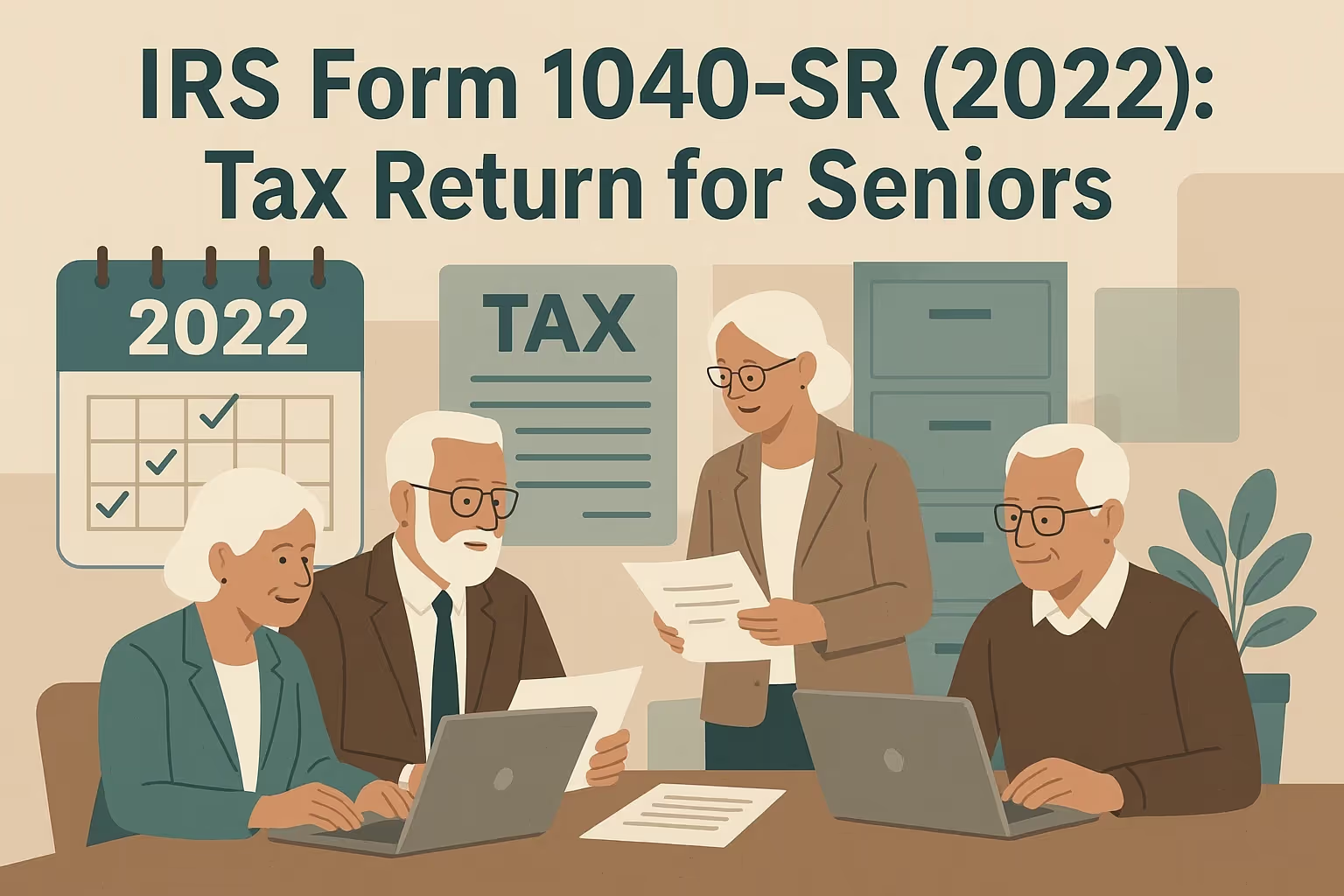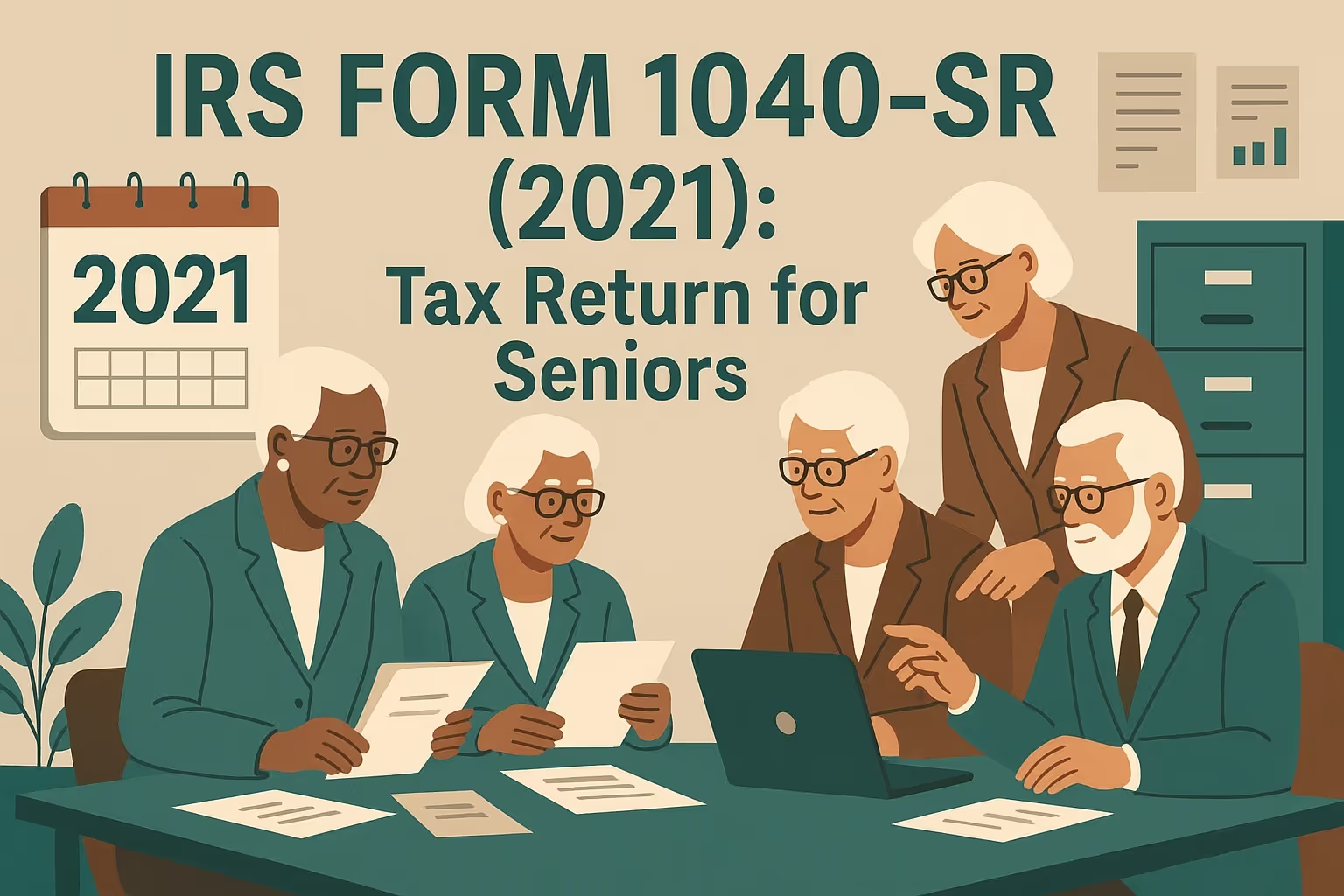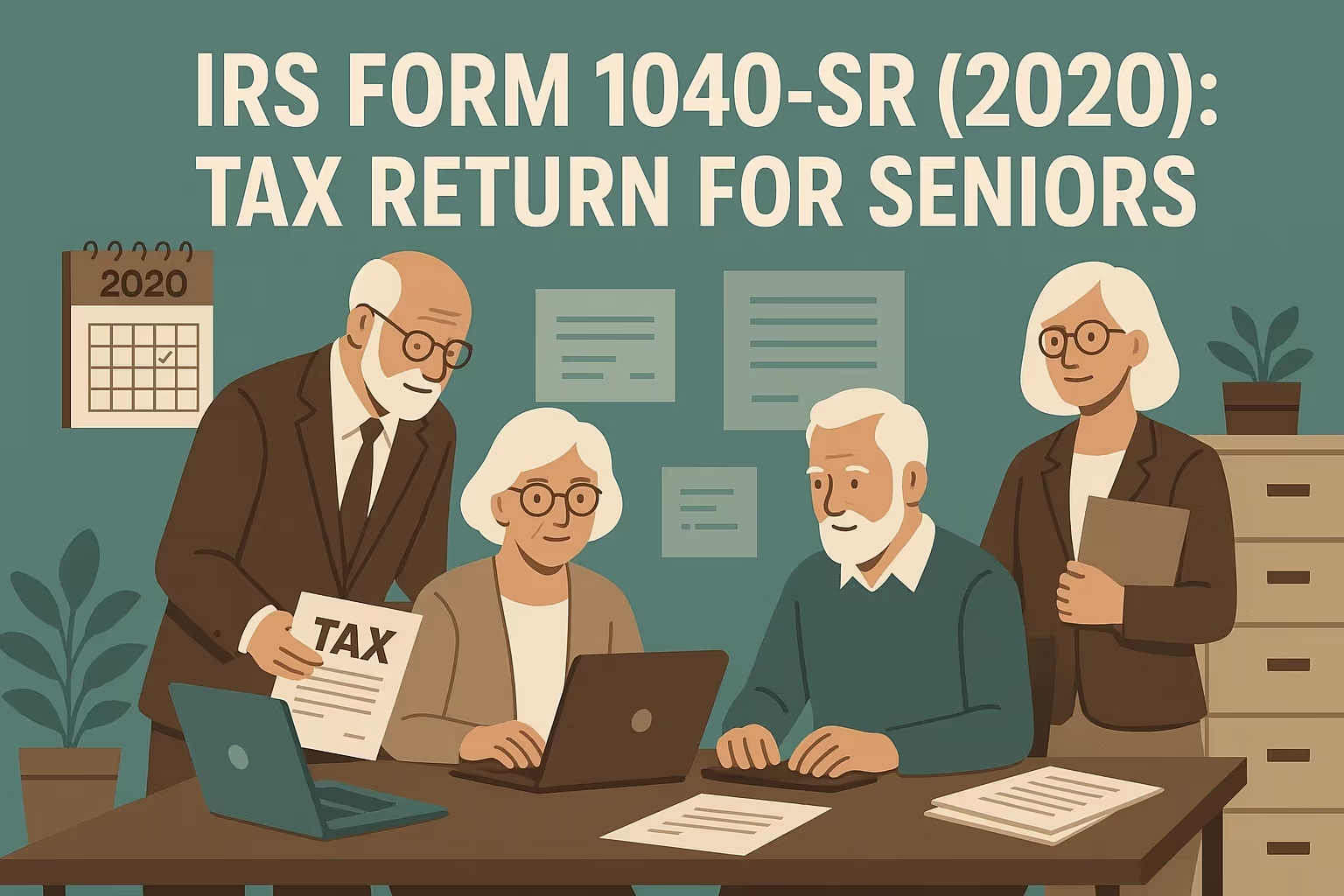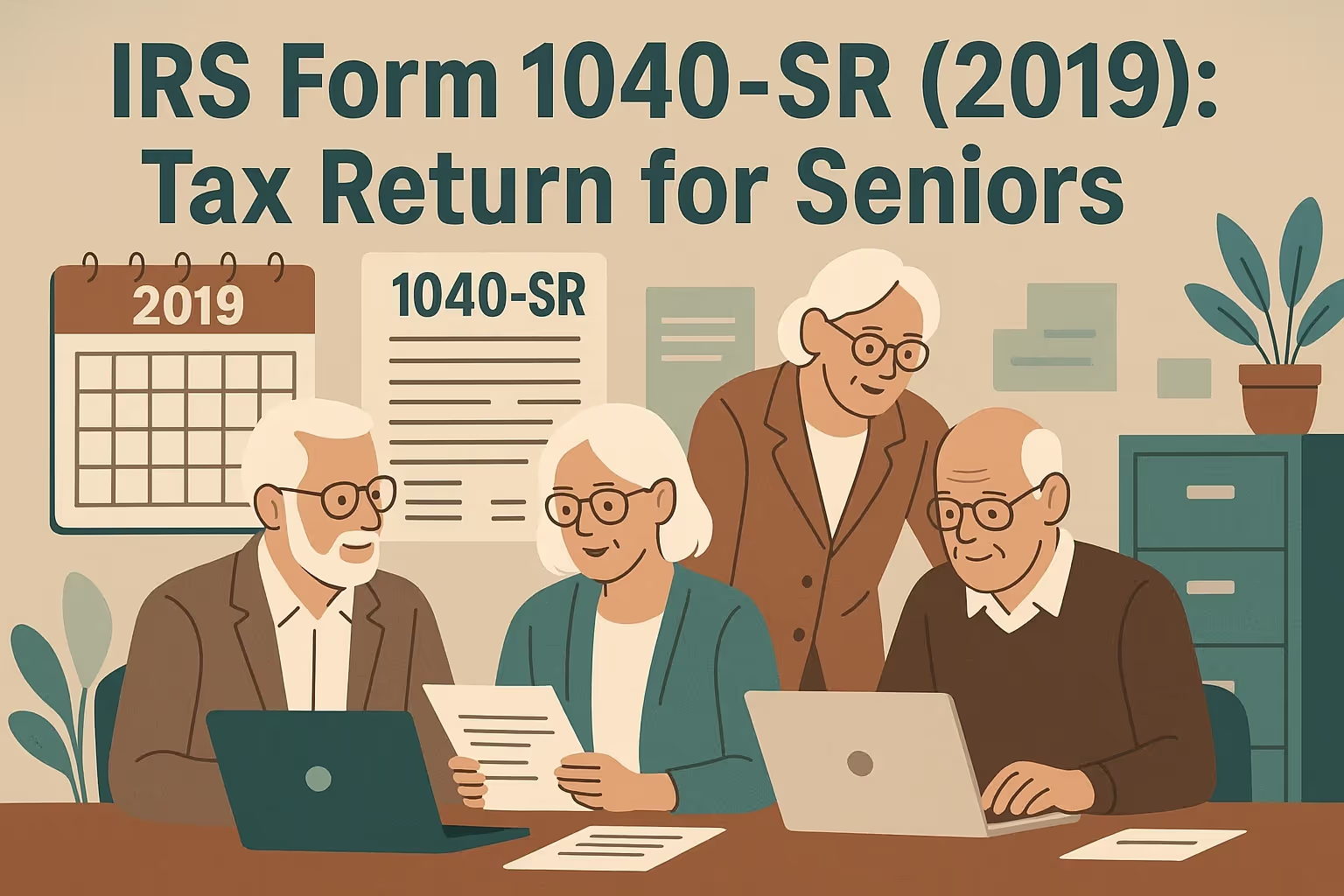Form 1040SR 2024 Instructions: Guide for Senior Taxpayers
Preparing your tax return often requires extra care once you reach age 65. To simplify the process, the IRS introduced Form 1040-SR, a version of the standard tax form designed specifically for seniors. It features larger print, precise spacing, and a standard deduction chart printed directly on the form. These improvements help make filing easier to read, understand, and complete without assistance.
The Form 1040SR 2024 instructions guide older adults through every part of the process—from reporting income and deductions to claiming tax credits. While it performs the same calculations as the regular Form 1040, its layout reduces visual strain and confusion, particularly for those managing Social Security benefits, pensions, or other retirement income. This user-friendly format helps seniors navigate filing requirements with less stress and greater clarity.
This step-by-step guide explains who can file Form 1040-SR, highlights what’s new for the 2024 tax year, and outlines key topics such as federal income tax withholding, estimated tax payments, and qualified retirement income. It also covers deductions, credits, and filing options tailored for taxpayers age 65 and older. Whether you file electronically or by mail, these instructions will help you prepare an accurate annual income tax return and avoid common mistakes. With the proper preparation, seniors can meet their IRS obligations easily and feel confident in every part of the filing process.
What Is Form 1040-SR?
Form 1040-SR is an easier-to-read version of Form 1040, created by the Internal Revenue Service for taxpayers 65 and older. It was introduced in 2019 to make filing federal income tax returns more accessible. The form includes larger print, clearer spacing, and a standard deduction chart printed directly on the first page. These features help seniors complete their tax returns without referencing multiple schedules or charts.
Although the layout differs, Form 1040-SR uses the same calculations and tax tables as the regular Form 1040. This means seniors receive the same results and tax benefits as any other filer. It provides a more readable format that reduces the risk of errors. The IRS encourages eligible taxpayers to use this form if it better meets their needs.
Who Can File Form 1040-SR?
To qualify, you must meet the age requirement of being born before January 2, 1960, which means you are 65 or older by December 31, 2024. The form can be used by any senior taxpayer, regardless of filing status—single, married filing jointly, married filing separately, head of household, or qualifying surviving spouse. There are no income limits or restrictions on the type of income reported.
For full details on eligibility and filing requirements, review the IRS Instructions for Form 1040 page.
What’s New for Tax Year 2024
The Form 1040-SR 2024 instructions highlight vital updates that senior taxpayers should know before filing. These changes affect standard deduction amounts, income reporting, and filing options under the Internal Revenue Service (IRS). Reviewing these updates helps ensure your annual income tax return is accurate and complete.
Updated Standard Deduction Amounts
The standard deduction for seniors in 2024 has increased to reflect inflation adjustments. The table below summarizes the new deduction amounts by filing status and includes the additional deductions for age 65 or blindness.
- Base Standard Deduction (2024): $14,600
- Additional Deduction (Age 65+ or Blind): $1,950
- Total Example (Both Spouses 65+): —
- Base Standard Deduction (2024): $29,200
- Additional Deduction (Age 65+ or Blind): $1,550 per spouse
- Total Example (Both Spouses 65+): $32,300
- Base Standard Deduction (2024): $21,900
- Additional Deduction (Age 65+ or Blind): $1,950
- Total Example (Both Spouses 65+): —
These increased amounts reduce taxable income for senior taxpayers. For example, a married couple whose spouses are 65 or older can claim a total deduction of $32,300. Using the standard deduction table directly printed on Form 1040-SR helps ensure these values are applied correctly.
Key IRS Updates for Seniors
Several updates apply to the 2024 tax year that may affect older adults:
- Form 1099-K Reporting Threshold: Seniors with small businesses or online sales will now receive Form 1099-K if total transactions exceed $5,000. The limit will be lowered to $600 starting in 2026.
- Digital Asset Question: All federal tax forms now include a required question about digital assets. Check “No” if you did not buy, sell, or trade cryptocurrency in 2024.
- IRS Direct File Expansion: The IRS has expanded its Direct File program to 25 states. This free option allows eligible taxpayers with simple returns to file directly with the IRS.
For a summary of senior-specific updates, refer to IRS Publication 554 - Tax Guide for Seniors.
Step-by-Step Guide to Filing Form 1040-SR
The Form 1040-SR 2024 instructions are designed to help taxpayers age 65 or older file with clarity and confidence. The following steps outline how to accurately prepare and complete your federal income tax return.
Step 1 – Confirm Eligibility and Choose a Filing Status
Begin by confirming that you meet the age 65 or older requirement. Then, select the filing status that best reflects your situation—single, married filing jointly, married filing separately, head of household, or qualifying surviving spouse. The IRS Form 1040-SR uses the same schedules and calculations as the standard Form 1040. Generally, both forms produce identical results, but 1040-SR offers larger print and easier readability.
Step 2 – Gather All Required Documents
Organize the documents needed to report all sources of income and deductions. These should include:
- Income Forms: W-2 for wages, Form SSA-1099 for Social Security benefits, Form 1099-R for pensions or distributions from qualified retirement plans, and Form 1099-G for unemployment compensation.
- Other Forms: Include any 1099-DIV or 1099-INT showing dividends or interest and prior returns from previous years.
- Schedules and Records: Collect proof of estimated tax payments, self-employment records, and documentation for student loan interest or other adjustments.
These will make completing your numbered schedules easier and help prevent errors.
Step 3 – Report Income and Additional Items
You must report all income accurately. The IRS considers taxable wages, retirement distributions, investment income, and certain other income as part of your total.
- Use Schedule 1 to report additional income such as self-employment earnings or taxable refunds.
- Use Schedule B if you have a financial interest in foreign accounts.
- Report any other payments or tax payments already made to ensure proper credit on your return.
If applicable, claim education credits or the student loan interest deduction to offset qualified expenses.
Step 4 – Choose Deductions and Claim Credits
When preparing your Form 1040-SR, it is essential to decide whether to take the standard deduction or use itemized deductions on Schedule A. Compare both carefully and choose the option that provides the most significant tax benefit for your situation. The Form 1040SR 2024 instructions include a clear standard deduction chart to help seniors confidently make this decision.
Standard Deduction:
- Most seniors choose the standard deduction because it includes an additional amount for seniors 65 or older or who are blind.
- This option is simpler and often provides the best benefit for retirees with low medical, tax, or mortgage expenses.
Itemized Deductions:
- Some taxpayers benefit more from itemizing if their deductible expenses exceed the standard deduction amount.
- Standard itemized deductions include medical costs exceeding 7.5% of adjusted gross income, property and state taxes, mortgage interest, and charitable donations.
- Always keep records and receipts to support your claims.
Tax Credits:
- The Child Tax Credit helps seniors who support qualifying dependents.
- The Foreign Tax Credit applies if you pay taxes in another country.
- Education and retirement savings credits can reduce your overall federal income tax owed.
Choosing the correct deductions and credits ensures you receive every benefit available and reduces the total amount you must pay.
Step 5 – Calculate Taxes and Include Required Schedules
After deductions, calculate your total federal tax using the official tables.
- Use Schedule 2 to record additional taxes, such as self-employment tax or other taxes related to investment income.
- Report all estimated tax payments and withholding.
- Double-check for the bipartisan budget act partnership income or adjustments requiring extra schedules.
Review every section carefully to confirm that the figures match your documents.
Step 6 – File, Pay, and Track Your Refund
Once complete, review the entire return. Ensure names, Social Security numbers, and totals are correct. Then:
- E-file for faster processing or mail your return using certified mail.
- Make any required tax payments through IRS Direct Pay, EFTPS, or check.
- If eligible for a tax refund, choose direct deposit for the quickest turnaround.
Following these steps allows you to file accurately, claim all benefits available to older adults, and maintain compliance with federal tax requirements.
Filing Methods for Seniors
The Form 1040SR 2024 instructions give taxpayers age 65 or older two main filing options—electronic filing or paper filing. The best choice depends on your comfort level, access to technology, and the complexity of your tax situation.
E-Filing (Recommended Option)
Filing electronically is the fastest and most reliable way to submit your annual income tax return. The Internal Revenue Service recommends e-filing because it improves accuracy, shortens processing time, and helps ensure faster refunds. It also reduces the risk of errors since most software automatically checks for mistakes before submission.
Free and Low-Cost E-Filing Options for Seniors:
- IRS Direct File: This no-cost service, now available in 25 states, allows eligible taxpayers to file directly with the IRS using an online system designed for simple returns.
- IRS Free File: Seniors with an adjusted gross income under $79,000 can use this program to access several approved software providers, including Form 1040-SR.
- Free Fillable Forms: This option works well for seniors who prefer entering data manually but still want the benefits of electronic filing. It follows the standard form and includes built-in error checks.
- VITA and TCE Programs: The Volunteer Income Tax Assistance (VITA) and Tax Counseling for the Elderly (TCE) programs provide free, in-person help for older adults. Volunteers assist with federal tax forms, credits, deductions, and filing questions.
E-filing ensures that the IRS receives your return immediately and typically processes refunds within 21 days when you choose direct deposit.
Paper Filing
Seniors who prefer a traditional method can still file a paper return. To do so, complete Form 1040-SR and attach all required documentation, such as W-2s, 1099s, and numbered schedules. Include copies of tax payments or withholding confirmations to verify accuracy.
Mail the completed return to your state's address listed in the IRS instructions, using certified mail to confirm delivery. Always keep copies for your records. Paper filing takes longer—usually six to eight weeks—but remains a valid and secure option for those who prefer mailing their forms.
Payment and Refund Options
After completing your Form 1040-SR, the next step is handling any balance due or tracking your refund. The Form 1040-SR 2024 instructions outline several secure ways to pay your taxes or receive your refund, depending on your financial situation. Managing payments correctly ensures you avoid penalties and helps keep your federal income tax record in good standing.
If You Owe Taxes
If your return shows a balance due, you can choose from several payment methods approved by the Internal Revenue Service:
- IRS Direct Pay: This free service lets you pay directly from your checking or savings account. It is one of the fastest and most secure payment options.
- Electronic Federal Tax Payment System (EFTPS): This system allows electronic payments online or by phone and is commonly used by retirees and self-employed taxpayers.
- Credit or Debit Card Payments: Although small service fees may apply, you can make payments online through authorized processors.
- Check or Money Order: You can mail your payment to the IRS along with Form 1040-V. Always make checks payable to “United States Treasury” and include your Social Security number and tax year.
If you cannot pay the full amount, the IRS offers installment agreements or an Offer in Compromise (OIC) to settle your balance. Seniors facing temporary financial hardship may also qualify for the Currently Not Collectible status.
If You Expect a Refund
Seniors expecting a refund can receive it fastest through direct deposit, which sends funds straight to your bank account. The IRS typically issues refunds within 21 days for e-filed returns. Always review your routing and account numbers carefully to avoid delays.
If you filed by mail, allow six to eight weeks for processing. Keeping a copy of your return and confirming tax payments ensures accurate recordkeeping for future tax years.
Common Mistakes to Avoid
Filing errors can slow down your tax refund or cause the IRS to question your return. Many mistakes can be prevented with a careful review before submission. The Form 1040SR 2024 instructions outline several areas where older taxpayers often make avoidable errors.
1. Personal Information Issues
Always double-check your identifying information. Names must appear exactly as they do on your Social Security cards, and Social Security numbers should match those records. If you moved recently, update your mailing address before filing. When filing jointly, both spouses must sign and date the return. Missing signatures are among the most common reasons a paper return is rejected.
2. Income and Deduction Errors
Every source of income must be reported. Ensure you include all W-2s, 1099s, Social Security benefits, pensions, and unemployment compensation records. If you earned additional income from self-employment or investments, report it on Schedule 1. Confirm that your medical or charitable expenses meet the required limits when claiming itemized deductions.
3. Math and Filing Oversights
Simple calculation errors can delay processing. Verify that your tax payments, withholding, and credits totals are correct. Attach all necessary numbered schedules and confirm that you answered the digital asset question with “Yes” or “No.” Finally, every line must be reviewed for accuracy before filing.
Taking a few extra minutes to review your return helps ensure that your federal income tax filing is complete and your refund arrives on time.
When You Don’t Need to File
Not every senior is required to file a federal income tax return each year. The Form 1040SR 2024 instructions explain that the general rule depends on your age, income level, and filing status. If your income is below certain limits, you may not need to file—but reviewing your situation carefully helps you feel confident about your decision.
Key Points for 2024:
- Age Requirement: To use Form 1040-SR, you must be 65 or older by December 31, 2024.
- Income Thresholds:
- Single: Seniors filing as single generally do not need to file a tax return if their total income is below $16,550 for 2024. This includes all taxable sources such as wages, pensions, and Social Security benefits.
- Married Filing Jointly: Seniors filing jointly typically do not need to submit a return if their combined income is below $32,300. Both spouses must meet the age requirement of 65 or older for this threshold to apply.
- Head of Household: Seniors filing as head of household may have higher income limits before filing is required. These thresholds vary each year but are generally greater than those for single filers.
- Single: Seniors filing as single generally do not need to file a tax return if their total income is below $16,550 for 2024. This includes all taxable sources such as wages, pensions, and Social Security benefits.
- Tax Withholding or Credits: Even if your income is below the limit, you may still file to claim refunds or credits from tax withholding or estimated payments.
- Recordkeeping: Filing voluntarily keeps your information current with the IRS, protecting eligibility for future benefits like Social Security.
The bigger print and simpler design of Form 1040-SR make it easier to verify your income against these limits and decide whether filing is necessary.
First-Time Filers and Assistance Resources
Filing Form 1040-SR for the first time can seem unfamiliar, especially for newly retired people or those recently turning 65. The Form 1040SR 2024 instructions make the process easier by outlining what documents to gather, how to report income, and where to find help. These steps can simplify filing and help seniors feel confident about their federal income tax return.
If You’re Filing for the First Time:
- Review Past Returns: Look at your previous returns or request a transcript from the IRS to ensure consistency in income reporting.
- Organize Documents Early: Gather W-2s, 1099s, and proof of tax payments or deductions before you begin.
- Use Trusted Tax Software: Programs that support Form 1040-SR can automatically calculate credits and deductions for seniors.
- Understand Common Credits: First-time filers should review eligibility for the Child Tax Credit, education credits, or the Credit for the Elderly or Disabled to reduce tax owed.
Free Assistance Programs:
- VITA (Volunteer Income Tax Assistance): Offers free help for low-to-moderate-income taxpayers.
- TCE (Tax Counseling for the Elderly): Provides guidance specifically for seniors.
- AARP Tax-Aide: Assists taxpayers age 50 and older with free in-person preparation.
These resources can help seniors file accurately and ensure all available tax credits and benefits are claimed.
Frequently Asked Questions (FAQs)
What is the difference between Form 1040 and Form 1040-SR?
Both forms calculate federal income tax similarly, but Form 1040-SR was created for seniors age 65 or older. It uses larger print and clearer spacing and includes a built-in standard deduction chart. The layout makes it easier to read and complete without changing tax rules or affecting how income and credits are calculated.
Do I need to make estimated tax payments?
You may need to make estimated tax payments if you earn income that isn’t subject to withholding, such as self-employment income, retirement distributions, or investment earnings. The IRS requires quarterly payments to avoid underpayment penalties. Seniors receiving pensions or Social Security can request voluntary withholding instead of sending separate estimated payments each quarter.
Where can I get official federal tax forms?
You can access federal tax forms such as Form 1040-SR, Schedule A, and related instructions directly from the IRS. Visit IRS.gov to download printable versions or file electronically through the IRS Free File program. Local libraries and community centers often keep paper copies for seniors who prefer mailing their returns instead of e-filing.
Can seniors claim the Child Tax Credit?
If you support a qualifying dependent, you may claim the Child Tax Credit even after age 65. Eligibility depends on the child’s age, relationship, and residency, as well as your income level. Claiming this credit can reduce your total federal tax owed or increase your refund if the credit exceeds your tax liability.
How do I report additional income?
Use Schedule 1 to report additional income not listed elsewhere on your Form 1040-SR. This may include self-employment earnings, taxable refunds, prizes, or jury duty pay. You should also report adjustments such as educator expenses or student loan interest. Including all additional income ensures accurate tax calculation and prevents IRS notices or return corrections.


















